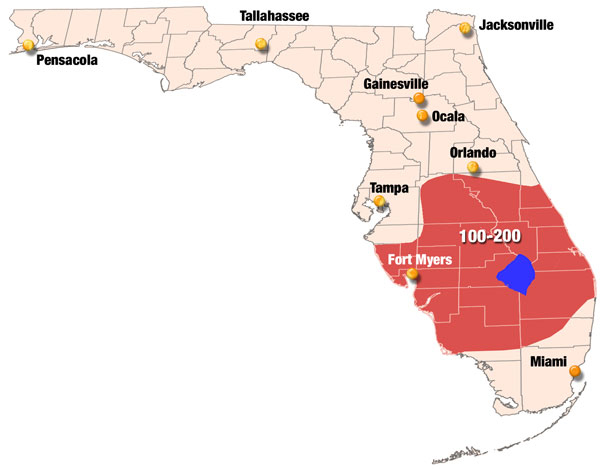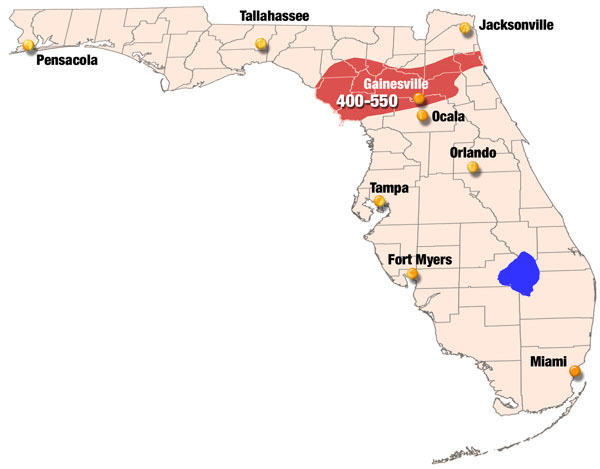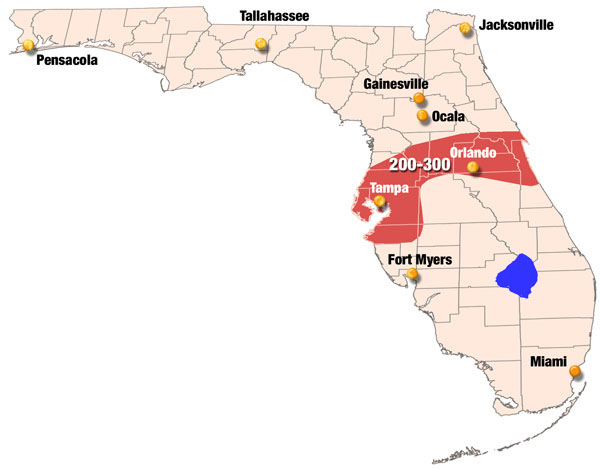Citrus Facts
Citrus is an integral part of Florida’s state identity. Here are some fun and interesting facts about Florida Citrus.
History of Citrus
- Citrus has been grown commercially in Florida since the mid-1800s.
- The first citrus was brought to the New World in 1493 by Christopher Columbus.
- In the mid-1500s one of the early Spanish explorers, most likely Ponce de Leon, planted the first orange trees around St. Augustine, Florida.
- Florida’s unique sandy soil and subtropical climate proved to be ideal for growing the seeds that the early settlers planted and have flourished ever since.
Citrus Products
- Florida growers produce several types of citrus, including oranges, grapefruit and speciality fruit including tangerines and tangelos.
- The primary varieties of Florida oranges are Valencia, Hamlin, and Vernia. This is constantly changing as more greening tolerant varities, like OLL #8 and Hamlin N13-32, have become available. The fresh orange season typically runs from October through June.
- The primary varieties of Florida grapefruit are Ruby Red, Flame, Ray Red and White Marsh Seedless. The fresh grapefruit season typically runs from September through June.
- Florida producers grow a handful of specialty fruit, which are in season from October through April.
Market Share and Value
- To learn more about the Citrus World Markets and Trade, visit https://apps.fas.usda.gov/psdonline/circulars/citrus.pdf to see trends for the last 5 years.
- Florida was once the leading producer of citrus in the world.
- Florida produces a significant portion of the U.S. supply of citrus, with a large percentage processed into orange juice.
- To view a chart on Florida Organge Production from 1959 – 2024, visit https://citrusindustry.net/2024/05/07/florida-orange-production-plummeted-years/
Acreage and Growing Areas
- As of 2024 in Florida, there are about 274,705 acres of citrus groves in the state.
- In 2004 in Florida, there was 748,555 acres of citrus groves in the state. The decline can be attributed to Huanglongbing (HLB) aka Citrus Greening predominantly; however development and hurricanes can attribute to some of the acreage that has been lost.
- Despite the challenges the Florida citrus industry has faced, Florida citrus acreage still tops in the United States. Visit https://citrusindustry.net/2024/03/29/florida-citrus-acreage-tops-united-states/ to learn more.
- Most citrus is grown in the southern two-thirds of the Florida peninsula, where there is low probability for a freeze. After a series of freezes in the 1980s, citrus growers gradually migrated southward from central and northern regions, although Polk County in the Central part of the state remains the top citrus producing county.
Growing and Harvesting
- To harvest the fruit once it’s ripe, workers carefully hand pick the fruit and place it in large canvas bags. The bags are then placed into specialized vehicles called “goats” that bring the harvested fruit from the grove to roadside tractor-trailers.
- Citrus grown for fresh consumption is hauled to packinghouses where it is washed, graded and packed.
- Citrus produced for juice is transported by truck to processing plants for juice extraction.
- At one time, there were about 40 citrus packinghouses and 20 citrus processing plants in Florida.
- As of 2025, there are 13 citrus packinghouses remaining in Florida.
- According the Florida Citrus Mutual, only six major processing plants remain, collectively operated by four companies.
Economic Impact to the State of Florida
- As of 2025, the growing, packing, processing, and selling of citrus generates nearly $6.8 billion per year impact on Florida’s economy.
- Nearly 35,000 Floridians work in the citrus industry or a related business.
Environmental Impact
- Citrus has a positive impact on Florida’s environment.
- A modern grove design allows for large areas of undeveloped land, providing an excellent wildlife habitat and a natural buffer between farmlands and urban development.
- University of Florida Researchers have observed more than 159 native species of wildlife within grove ecosystems.
- Research shows that for every acre of mature trees, 16.7 tons of oxygen is produced per year.
Varieties
Floridaglo

Flordaglo is a white flesh peach requiring about 150 chill units. Fruit have high red overcolor on melting white flesh with a semicling pit and develops in 78 days. Fruit size is 2.5 to 2.5 inches in diameter and it ripens late April and early May.
UFO

UFO’is a peach variety with a low winter chilling requirement of approximately 250 chill units (cu). Trees of ‘UFO’ are of large size and highly vigorous with a semi-upright growth habit. Trees of ‘UFO’ regularly bear heavy annual crops of fruit which are large for the moderately early ripening season. Fruit of ‘UFO’ are very firm with a yellow, non-melting flesh which are semi-freestone and of peento shape.
Fruit of ‘UFO’ are uniform and substantially symmetrical in shape and have an attractive 50 to 70% striped red skin color and a diameter of 2.5 inches. The fruit of ‘UFO’ ripens ten (10) to fifteen (15) days after that of ‘UFGold’ peach in mid-to-late May in Gainesville, Florida.
UFGlo

‘UFGlo’ is a peach variety with a winter chilling requirement of approximately 400 chill units (cu) and a diameter of 2.5 to 2.75 inches. Trees of ‘UFGlo’ are vigorous, semi-spreading, and produce an attractive, sweet tasting, white, and non-melting flesh fruit intended for the fresh fruit market. The fruit development period is 80 days. Trees of ‘UFGlo’ produce fruit with tree-ripened taste while retaining firmness for longer shelf life than fruit from conventional melting-flesh cultivars.
‘UFGlo’ has fruited well where the coldest month averages 54-57 degrees F, and in colder locations in the absence of spring frosts. It is expected that ‘UFGlo’ will be well adapted to areas where ‘Flordaking’ is grown successfully. ‘UFGlo’ is expected to supplement ‘UFSharp’ Peach in north central Florida.
UFOne

‘UFOne’ is a peach variety with a low winter chilling requirement of approximately 250 chill units (cu). Trees of ‘UFOne’ are of medium size and moderately vigorous with a semi-spreading growth habit. Trees of ‘UFOne’ are self-fertile and regularly bear heavy annual crops of early season fruit which are medium large for its mid-early ripening season. Fruit of ‘UFOne’ are very firm with a yellow, non-melting flesh which are semi-clingstone and a diameter of 2.5 to 2.75 inches.Fruit of ‘UFOne’ are uniform and substantially symmetrical in shape and have an attractive light red color over 40% of skin. Fruit of ‘UFOne’ which is exposed to sunlight has a higher degree of enhanced red skin. The fruit of ‘UFOne’ ripens about 95 days from full bloom, which is approximately eight (8) days after that of ‘UFBeauty’ peach in early May in Gainesville, Florida.
Floridabest

‘Flordabest’ is a low chill peach variety with a winter chilling requirement estimated at 250 chill units (cu). The tree is of medium size and has a moderate vigorous and semi-upright growth habit. Trees of ‘Flordabest’ are self-fertile and regularly bear heavy annual crops of early season fruit that are large for its ripening season. Fruit are uniformly firm and yellow with melting flesh which are semi-clingstone with a diameter of 2.5 inches.
Fruit of ‘Flordabest’ are oval and uniform with substantially symmetrical shape and have an attractive 90 to 100% bright red skin.
UFSharp

‘UFSharp’ peach is released for grower trials by the University of Florida Agricultural Experiment Station. It was named to honor Professor R.H. Sharpe, the pioneer of the University of Florida fruit breeding program.
Trees of ‘UFSharp’ produce an attractive, sweet-tasting, yellow and non-melting flesh fruit intended for the fresh fruit market. This cultivar produces fruit with tree-ripened aroma and taste while retaining firmness for longer shelf life than fruit from conventional melting-flesh cultivars. UFSharp is a peach variety with a low winter chilling requirement of approximately 325 chill units (cu) and a fruit development period of 105 days. UFSharp has a diameter of 2.25 to 3 inches.
Tropic Beauty

Tropic Beauty is a medium size, red skinned (60% red) semi-freestone with soft, yellow melting flesh that ripens in mid-May. This peach has excellent flavor and is self-pollinating. TropicBeauty has 150 chill hours requirement and grows to a diameter of 2.25 to 2.5 inches. Fruit development period is 89 days.
TropicBeauty is the ideal choice for homeowners, u-pick operations, roadside stands because of self-ripening qualities.
UFBeauty

‘UFBeauty’ is a peach variety with a low winter chilling requirement of approximately 200 chill units (cu). Trees of ‘UFBeauty’ are of large size and highly vigorous with a semi-spreading growth habit. Trees of ‘UFBeauty’ regularly bear heavy annual crops of early mid-season fruit which are medium large for its ripening season.
Fruit of ‘UFBeauty’ are very firm with a yellow, non-melting flesh which are clingstone. Fruit of ‘UFBeauty’ are uniform and substantially symmetrical in shape and have an attractive 90 to 100% red skin with darker red stripes. Fruit development period is 82 days. Fruit diameter is 2.5 inches.
UFSun

‘UFSun’ is a peach variety with a low winter chilling requirement of approximately 100 to 150 chill units (cu). Trees of ‘UFSun’ are of large size and highly vigorous with a semi-spreading growth habit. Trees of ‘UFSun’ regularly bear heavy annual crops of early season fruit which are medium size for its ripening season. Fruit of ‘UFSun’ are very firm with a yellow, non-melting flesh which are clingstone with a diameter of 2.25 to 2.5 inches.
Fruit of ‘UFSun’ are uniform and substantially symmetrical in shape and have an attractive 50 to 60% red skin with darker red stripes. The fruit of ‘UFSun’ ripens about 80 to 85 days from full bloom, with that of ‘Flordaprince’ peach, in late April at Immokalee, Florida and Gainesville, Florida.
UFBest

‘UFBest’ is an attractive, high-quality peach with yellow, high blush, sweet-tasting, non-melting flesh, with early ripening habits. This variety produces fruit with a tree-ripened aroma and sweetness that softens slowly, allowing for longer shelf life than fruit from conventional melting-flesh cultivars. Trees possess a low-chilling requirement of approximately 100 chill units (cu).
Fruit are medium and average 3.5 to 4.5 ounces and up to 2.75 inches in diameter. Ripe fruit have an attractiveness near 100% red skin with a golden yellow ground color. Fruit ripens about 85 days from full bloom, in late April to early May in Gainesville, FL. UFBest performs well in areas where ‘UFSun’ and ‘Tropicbeauty’ are grown successfully.
Florida Prince

FlordaPrince is a standard for a low chill early-ripening peach with a requirement of 150 chill units (cu). FlordaPrince grows to a diameter of 2 inches with a yellow melting flesh. Fruit matures in March and April and has a fruit development period of 78 days which makes them ideal for local markets.
UFGem

‘UF Gem’ is a new peach variety comparable to ‘UFBeauty’ with a low winter chilling requirement of approximately 100-150 chill units (cu). Trees of ‘UF Gem’ are of large size and highly vigorous with a semi-spreading growth habit. Trees of ‘UF Gem’ regularly bear heavy annual crops of early mid-season fruit which are medium large for its ripening season.
Fruit of ‘UF Gem’ are very firm with a yellow, non-melting flesh which are clingstone. Fruit of ‘UF Gem’ are uniform and substantially symmetrical in shape and have an attractive 90% red skin with darker red stripes. Fruit development period is 80 days. Fruit diameter is 2.5 to 2.85 inches.